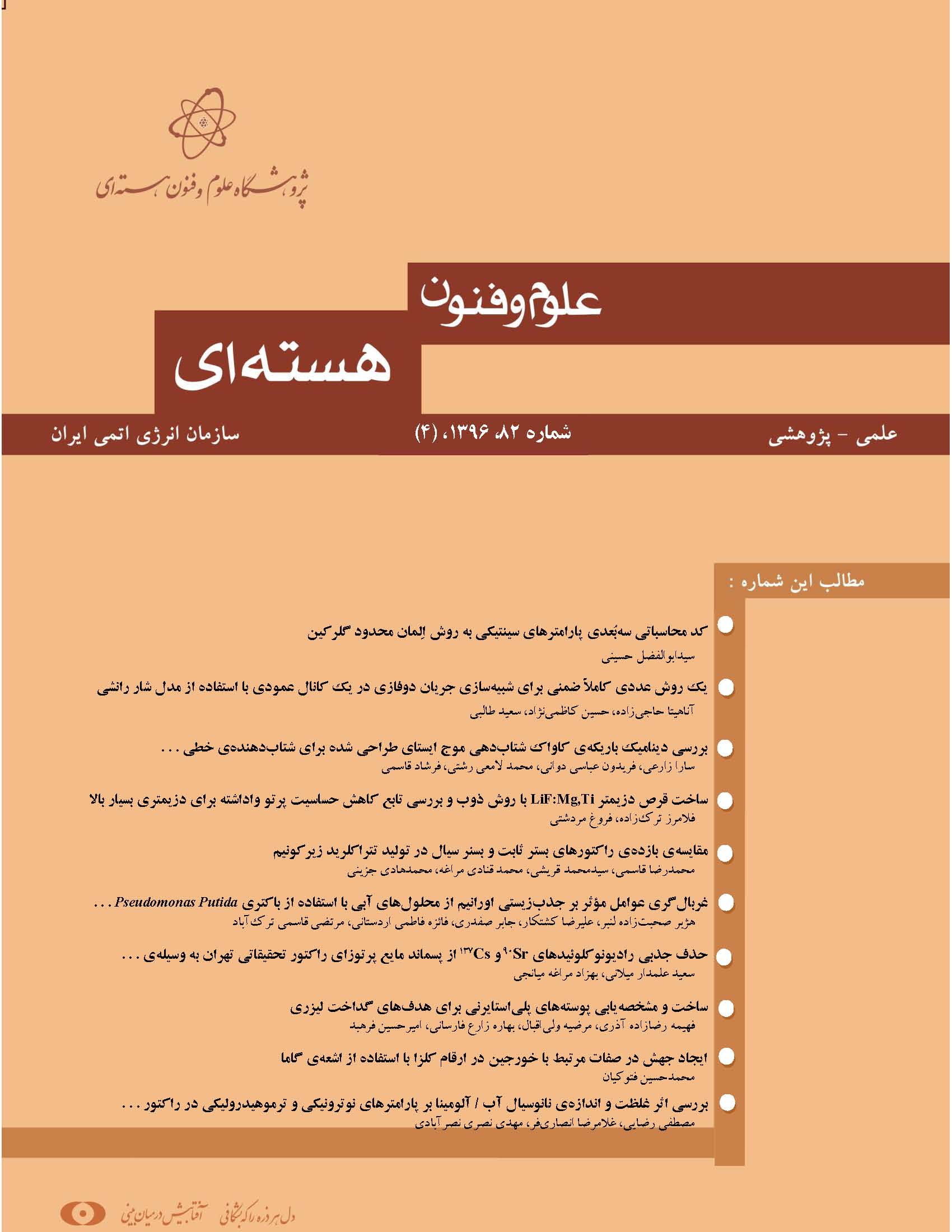نوع مقاله : مقاله پژوهشی
نویسندگان
پژوهشکدهی مواد و سوخت هستهای، پژوهشگاه علوم و فنون هستهای، سازمان انرژی اتمی ایران
چکیده
جداسازی فلزهای سنگین از پساب صنعتی، معضل زیستمحیطی جدی به ویژه در کشورهای در حال توسعه است. از میان فناوریهای آمایشی متعدد، به نظر میرسد که جذبزیستی گزینهی مناسبی باشد. جاذبهای زیستی پایه میکروبی برای حذف فلزهای سنگین از محلولهای آبی، مؤثر و کاربردیاند. در مطالعهی حاضر، توانایی باکتری Pseudomonas putida تثبیت شده بر روی کیتوزان برای جذبزیستی اورانیم (VI) از محلولهای آبی بررسی شد. غربالگری عوامل مؤثر بر فرایند جذبزیستی به کمک طراحی پلکت- برمن صورت گرفت. نتایج تجربی نشان داد که مقدار جاذبزیستی، غلظت اولیه اورانیم، اندازهی ذرات جاذبزیستی، درصد وزنی باکتری در جاذبزیستی و pH، به ترتیب بیشترین تأثیر را بر میزان جذب دارند، در حالیکه دما یک پارامتر غیرمؤثر تشخیص داده شد. بیشینهی ظرفیت جذبزیستی عملی برای جاذبزیستی حاوی 15% وزنی باکتری و معادلmg/g 536.08 به دست آمد. ایزوترمهای جذبزیستی با استفاده از مدلهای لانگمویر، فرندلیچ و دابینین- رادوشکویچ تحلیل شد. برای جاذبزیستی، مدل لانگمویر (0.983=R2) بهترین برازش را با دادههای تعادلی از خود نشان داد و بیشینه ظرفیت به دست آمده از این مدل برای این جاذبزیستی 588.23 و برای کیتوزان خالص mg/g 454.54 بود. در نتیجه، مطالعهی حاضر نشان داد که جاذبزیستی تهیه شده میتواند موردی مناسب برای جذبزیستی اورانیم باشد.
کلیدواژهها
عنوان مقاله [English]
Screening of Significant Factors in Uranium Biosorption from Aqueous Solutions Using Pseudomonas Putida Immobilized on Chitosan
نویسندگان [English]
- H Sohbatzadeh Lonbar
- A Keshtkar
- J Safdari
- F Fatemi Ardestani
- M Ghasemi Torkabadi
چکیده [English]
Heavy metal sequestration from industrial wastewater is a serious environmental problem especially in developing countries. Among various treatment technologies, it seems that biosoprtion is a promising alternative method. Microbial–based biosorbents are effective and applicable for heavy metals removal from aqueous solutions. The present study investigated the ability of Pseudomonas putida immobilized on chitosan to adsorb uranium (VI) from the aqueous solution. The biosorption process factors were screened using Plackett–Burman design. The results showed that the biosorbent dosage, initial concentration, biosorbent particle size, bacteria wt.% in the biosorbent and pH were the most significant parameters, respectively while temperature was the only insignificant parameter in the biosorption process. Maximum practical biosorption capacity was 536.08 mg g–1 obtained from 15 wt.% of the bacterial cells immobilized on chitosan. Biosorption equilibrium isotherms were analyzed by Langmuir, Freundlich and Dubinin–Radushkevhch models. For Pseudomonas putida immobilized on chitosan, the Langmuir isotherm model (R2=0.983) was proved to fit the equilibrium data best with the maximum capacities of 588.23 and 454.54 mg g–1 for the biosorbent and pure chitosan, respectively. In conclusion, the present study indicated that the prepared composite biosorbent could be a suitable candidate for uranium (VI) biosorption.
کلیدواژهها [English]
- Biosorption
- Uranium(VI)
- Bacterium
- Pseudomonas Putida
- Chitosan

